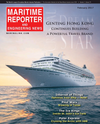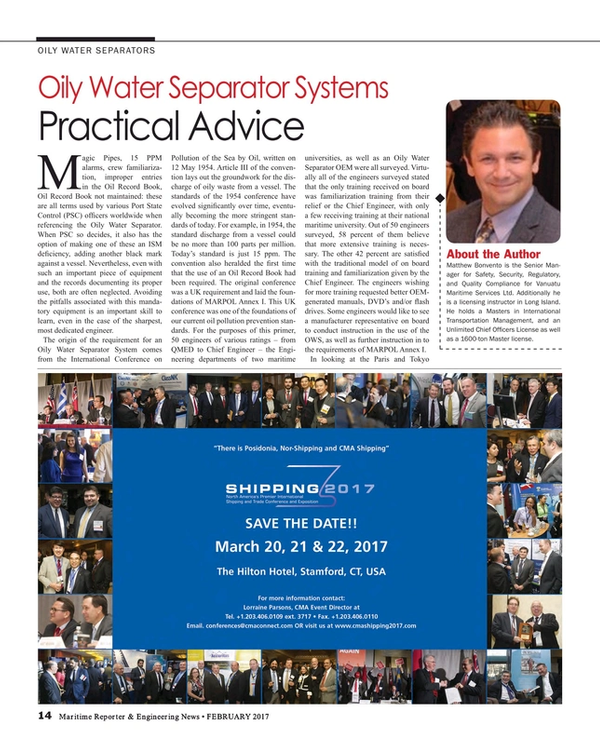
Oily Water Separator Systems: Practical Advice
Magic Pipes, 15 PPM alarms, crew familiarization, improper entries in the oil record book, oil record book not maintained: these are all terms used by various Port State Control (PSC) officers worldwide when referencing the oily water separator. When PSC so decides, it also has the option of making one of these an ISM deficiency, adding another black mark against a vessel. Nevertheless, even with such an important piece of equipment and the records documenting its proper use, both are often neglected. Avoiding the pitfalls associated with this mandatory equipment is an important skill to learn, even in the case of the sharpest, most dedicated engineer.
The origin of the requirement for an oily water separator system comes from the International Conference on Pollution of the Sea by Oil, written on May 12, 1954. Article III of the convention lays out the groundwork for the discharge of oily waste from a vessel. The standards of the 1954 conference have evolved significantly over time, eventually becoming the more stringent standards of today. For example, in 1954, the standard discharge from a vessel could be no more than 100 parts per million. Today’s standard is just 15 ppm. The convention also heralded the first time that the use of an oil record book had been required. The original conference was a U.K. requirement and laid the foundations of MARPOL Annex I. This U.K. conference was one of the foundations of our current oil pollution prevention standards. For the purposes of this primer, 50 engineers of various ratings – from QMED to chief engineer – the engineering departments of two maritime universities, as well as an oily water separator OEM were all surveyed. Virtually all of the engineers surveyed stated that the only training received on board was familiarization training from their relief or the chief engineer, with only a few receiving training at their national maritime university. Out of 50 engineers surveyed, 58 percent of them believe that more extensive training is necessary. The other 42 percent are satisfied with the traditional model of on board training and familiarization given by the chief engineer. The engineers wishing for more training requested better OEM-generated manuals, DVDs and/or flash drives. Some engineers would like to see a manufacturer representative on board to conduct instruction in the use of the OWS, as well as further instruction in to the requirements of MARPOL Annex I.
In looking at the Paris and Tokyo MOUs, only about two percent of the deficiencies noted by Port State Control had anything to do with MARPOL Annex I in the years 2013 and 2014. That said; of all the Port State Control Form Bs reviewed, nearly all involved non-functioning, malfunctioning, or bypassed Oily Water Separators, which resulted in a detention.
While it is possible to receive a dispensation for repairs from the flag state, that’s not always the case, and a vesseldetained awaiting parts and repair can cost valuable time and money. Additionally, these types of detentions can trigger the Flag State or Recognized Organization to require an Intermediate ISM audit. That’s because an infraction into vessel pollution is almost inevitably considered a safety management deficiency as well. The devil is in the details, but when it comes to Coast Guard, PSC, and/or accident inspections, one thread becomes very clear: the oil record book is the gateway into determining if the oily water separator is actually used, and if it is used, is it used appropriately. MEPC.1/Circ 736/REV.2 provides instructions and examples in to the proper entry requirements of the oil record book.
Addressing this situation head on, the 58 percent of engineers who wish to see change would like to see the equipment manuals on board with colored picture diagrams, as well as have the units labeled and color coded to ensure that each part of the system can be easily identified. Adjustments such as these are easy enough to implement at very little cost to the vessel owner or manager. The remainder of the engineers expressed a desire for more detailed training provided at either the university or the company level. Not to sound like a disgruntled deckie, but if we were to look at what the requirements that are under Table A/II-1 and Table A/II-2, ECDIS is a standalone requirement going so far as to require deck officers to have the training in the type specific units that are on board the vessel. The IMO believes that type specific and generic training, working in conjunction with each other, is necessary to reduce the amount of casualties that can be caused by the over reliance on ECDIS. Having sailed on a number of vessels with ECDIS, prior to the carriage requirement, the only way to learn the system prior to these requirements was to read the manual and hope that your relief left decent turnover notes. In my experience this often left to conflicting use of the system by the various officers of the watch who may have been shown the usage of the system differently.
Looking at OWS systems as critical equipment – like GMDSS, or ECDIS, for example – then it would follow that at the very minimum there should be a generic training covering the basic science such as the physics and principles behind the operation of the OWS system. Another overlooked aspect of this issue involves such variables such as the types of oils, lubricants, detergents – which vary greatly from vessel to vessel and port to port – and their collective impact on the hardware. Engineers not equipped with the knowledge of how this plays a factor in operations will have a difficult time operating the same equipment with competence, or in compliance.
As we progress with technological advances, toward more unmanned machinery and autonomous operations, greater burden will be placed on those left on board to run this critical equipment. If more than half of the engineers surveyed believe that we should be doing more in regards to training, then perhaps it is time to listen to them.
Read Oily Water Separator Systems: Practical Advice in Pdf, Flash or Html5 edition of February 2017 Maritime Reporter
Other stories from February 2017 issue
Content
- Coral Reefs: A Unique Natural Resource page: 12
- Oily Water Separator Systems: Practical Advice page: 14
- Last Port of Call for the U.S. Merchant Marine? page: 16
- Inside Brazil's Cuise Slump page: 20
- Meyer Turku Builds Big page: 24
- ABB: Propelling the Polar Cruise Boom page: 26
- Interview: Tan Sri Kt Lim, Chairman, Genting Hong Kong page: 33
- Ice Kings: Model Testing Ship-ice Interactions page: 34
- How Eagle Bulk Shipping is Using Big Data page: 38
- Rolls-Royce Blue Ocean Team Looks to the Future page: 40
- Industry 4.0 on the High Seas page: 43
- Digital Tech Turning Around Marine Prospects in Uncertain Waters page: 43
- KVH Is On 'Watch' page: 46
- Offshore Innovation: A Real ‘Riverboat’ page: 48


